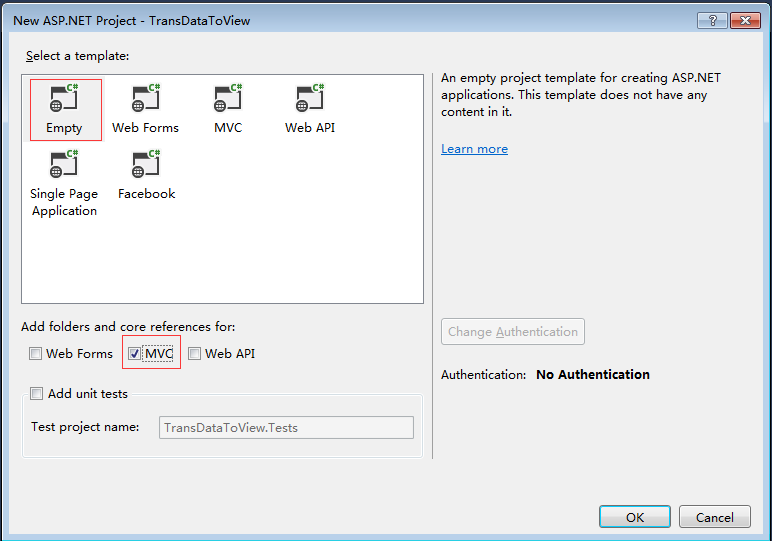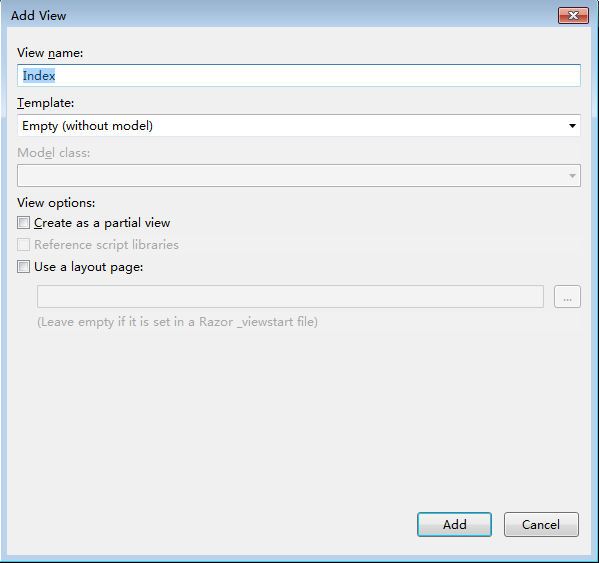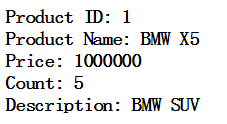总结ASP.NET MVC Web Application中将数据显示到View中的几种方式
当我们用ASP.NET MVC开发Web应用程序的时候,我们都是将需要呈现的数据通过"Controllers"传输到"View"当中,怎么去实现,下面我介绍一下我在实际工作当中用到过的几种方式。
创建一个ASP.NET MVC Web Application
在Visual Studio中创建ASP.NET Web Application应用程序,在向导的下一个窗口中选择空的模板。

创建Model
接着我们在Models文件夹下创建一个Product类,用来传递数据。
1 public class Product 2 { 3 public int ProductID { get; set; } 4 public string ProductName { get; set; } 5 public decimal Price { get; set; } 6 public int Count { get; set; } 7 public string Description { get; set; } 8 }
创建Controller
接着在Controllers文件下创建一个Controller, 命名为"ProductController"。
创建View
然后我们在Views -> Product目录下创建一个View,命名为Index。

到此,我们创建好了Model,View,Controller,在开始运行之前,我们需要更改一下默认路由配置。打开App_Start目录下的RouteConfig.cs文件,并更改默认路由如下:
1 public class RouteConfig 2 { 3 public static void RegisterRoutes(RouteCollection routes) 4 { 5 routes.IgnoreRoute("{resource}.axd/{*pathInfo}"); 6 7 routes.MapRoute( 8 name: "Default", 9 url: "{controller}/{action}/{id}", 10 defaults: new { controller = "Product", action = "Index", id = UrlParameter.Optional } 11 ); 12 } 13 }
好了,下面我们就正式开始实现数据从"Controller"到"View"的实现。
1. 使用ViewData。
ViewData是一个字典,它存放的是键值对。
打开新建好的ProductController.cs,使用using引入Product类所在的命名空间,在Index的Action里创建一个Product对象并且赋值给一个ViewData。
using TransDataToView.Models;
1 public ActionResult Index() 2 { 3 Product product = new Product 4 { 5 ProductID = 1, 6 ProductName = "BMW X5", 7 Price = 1000000, 8 Count = 5, 9 Description = "BMW SUV" 10 }; 11 12 ViewData["Product"] = product; 13 14 return View(); 15 }
接着,我们打开新建好的Index View文件,对Controller里的ViewData数据进行接收处理。
1 @using TransDataToView.Models 2 @{ 3 Layout = null; 4 } 5 6 <!DOCTYPE html> 7 8 <html> 9 <head> 10 <meta name="viewport" content="width=device-width" /> 11 <title>Index</title> 12 </head> 13 <body> 14 <div> 15 @{ 16 var product = (Product)ViewData["Product"]; 17 } 18 <h2> 19 Product ID: @product.ProductID <br /> 20 Product Name: @product.ProductName <br /> 21 Price: @product.Price <br /> 22 Count: @product.Count <br /> 23 Description: @product.Description 24 </h2> 25 </div> 26 </body> 27 </html>

因为我们需要将ViewData数据转换成需要的Product对象数据,所以这里要引入Produdct类所在的命名空间,使用@符号,也就是Razor语法来引入,定义,赋值等操作。
2. 使用ViewBag。
ViewBag它跟ViewData一样,都是字典值,但它存放的不是键值对,而是dynamic动态类型,这是ASP.NET MVC3新增的部分。
同样我们在Index Action里将Proudct对象赋值给一个ViewBag。
public ActionResult Index() { Product product = new Product { ProductID = 1, ProductName = "BMW X5", Price = 1000000, Count = 5, Description = "BMW SUV" }; ViewBag.Product = product; return View(); }
同样,我们打开Index View文件,对Controller里的ViewBag数据进行接收处理。
1 @{ 2 Layout = null; 3 } 4 5 <!DOCTYPE html> 6 7 <html> 8 <head> 9 <meta name="viewport" content="width=device-width" /> 10 <title>Index</title> 11 </head> 12 <body> 13 <div> 14 <h3> 15 Product ID: @ViewBag.Product.ProductID <br /> 16 Product Name: @ViewBag.Product.ProductName <br /> 17 Price: @ViewBag.Product.Price <br /> 18 Count: @ViewBag.Product.Count <br /> 19 Description: @ViewBag.Product.Description 20 </h3> 21 </div> 22 </body> 23 </html>
可以看到ViewBag不需要转型直接就可以使用里面的数据了。
3. 使用TempData。
TempData也是字典,它的使用完全等同于ViewData,两者之间最大的差异是TempData对数据的保存是临时性的。也就是它请求后,数据就被清除,也就是只能通过一次Controller传递。通常用于Action之间的一次性传递,所以它一般不直接用于传递到View中。
我们增加一个名为"TempDataIndex"的Action。
Controller:
1 public ActionResult Index() 2 { 3 ViewData["Message"] = "This is a View Data Message."; 4 5 if (TempData["Message"] != null) 6 ViewData["Message"] = TempData["Message"]; 7 8 return View(); 9 } 10 11 public ActionResult TempDataIndex() 12 { 13 TempData["Message"] = "This is a Temp Data Message."; 14 15 return RedirectToAction("Index"); 16 }
View:
1 <div> 2 <h3> 3 @ViewData["Message"] 4 </h3> 5 </div>
我们运行程序。结果如下:
此时TempData数据为null,我们导航到/Product/TempDataIndex下,结果如下:

我们看到通过TempDataIndex的Action里,TempData["Message"]有了数据,然后转向了Index的Action方法里,所以TempData的值赋给了ViewData。这是我们刷新一下页面,结果如下:

4. 使用View(object)。
通过直接传递object数据到View中。
1 public ActionResult Index() 2 { 3 Product product = new Product 4 { 5 ProductID = 1, 6 ProductName = "BMW X5", 7 Price = 1000000, 8 Count = 5, 9 Description = "BMW SUV" 10 }; 11 12 return View(product); 13 }
那么在View文件中需要绑定Controller里传递的对象。
1 @using TransDataToView.Models 2 @model TransDataToView.Models.Product 3 @{ 4 Layout = null; 5 } 6 7 <!DOCTYPE html> 8 9 <html> 10 <head> 11 <meta name="viewport" content="width=device-width" /> 12 <title>Index</title> 13 </head> 14 <body> 15 <div> 16 <h2> 17 Product ID: @Model.ProductID <br /> 18 Product Name: @Model.ProductName <br /> 19 Price: @Model.Price <br /> 20 Count: @Model.Count <br /> 21 Description: @Model.Description 22 </h2> 23 </div> 24 </body> 25 </html>
@model TransDataToView.Models.Product 意思就是绑定的是Product对象的Model,然后使用@Model.字段属性名来取值。
好了,本篇就先到此,希望对你有所帮助,谢谢!



